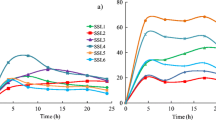Abstract
Soil samples taken monthly from the Burgan South oil field of Kuwait for one year degraded crude oil, phenanthrene, and hexadecane. Bacteria were better degraders at high-temperature (55°C) than fungi, especially in the drier, hotter months. Depending on the period of sampling, bacteria degraded hydrocarbons in the range of 46–86% (crude oil), 42–100% (hexadecane) and 5–58% (phenanthrene). Fungi alone accounted for degradation by 20–81% (crude oil), 30–95% (hexadecane) and less than 55% (phenanthrene).
Similar content being viewed by others
References
Al-Gounaim M.Y., Diab A., Al-Abdulla R., Al-Zamil N.: Effects of petroleum on the microbial populations of the desert soil of Kuwait.Arab. J. Sci. Res.13, 653–672 (1995).
Al-Hassan R., Al-Bader D., Sorkhoh N., Radwan S.S.: Evidence forn-alkane-consumption and oxidation by filamentous cyano-bacteria from oil contaminated coasts of the Arabian Gulf.Mar. Biol.130, 521–528 (1998).
Anderson J.P.E., Domsch K.H.: Measurement of bacterial and fungal contributions to respiration of selected agricultural and forest soils.Can. J. Microbiol.21, 314–322 (1975).
April T.M., Abbot S.P., Foght J.M., Currah R.S.: Degradation of hydrocarbons in crude oil by the ascomycetePseudallescheria boydii (Microascaceae).Can. J. Microbiol.44, 270–278 (1998).
Damborský J., Damborská M., Štipek S., Jesenská A., Trantírek L., Sklenář V.: Effect of the carbon source on assessment of degrading bacteria with the spread-plating technique duringin situ bioremediation.Folia Microbiol.45, 35–40 (2000).
Hunter-Cevera J.C., Fonda M.E., Bett A.: Isolation of cultures, pp. 3–23 in A.L. Demain, N.A. Solomon (Eds.),Manual of Industrial Microbiology. American Society for Microbiology, Washington (DC) 1986.
Ilori M.O., Amund D.O., Robinson G.K.: Ultrastructure of two oil-degrading bacteria isolated from the tropical soil environment.Folia Microbiol.45, 259–262 (2000).
Jones D., Collins M.D.: Irregular, non-sporing, Gram-positive rods, pp. 1261–1431 in P.H.A. Sneath (Ed.)Bergey's Manual of Systematic Bacteriology, Vol 2. Williams and Wilkins, Baltimore 1986.
Lal B., Khanna S.: Degradation of crude oil byAcinetobacter calcoaceticus andAlcaligenes odorans.J. Appl. Bacteriol.81, 355–362 (1996).
Leahy J.G., Colwell R.R.: Microbial degradation of hydrocarbons in the environment.Microbiol. Rev.54, 305–315 (1990).
Loginova L.G., Bogdandva T.I., Seregina I.M.: Growth of obligate thermophilic bacterium in a medium with paraffin.Mikrobiologiya50, 49–54 (1981).
Martens R., Zadrazil F.: Screening of white-rot fungi for their ability to mineralize polycyclic aromatic hydrocarbons in soil.Folia Microbiol.43, 97–103 (1998).
Obuekwe C.O., Al-Zarban S.S.: Bioremediation of crude oil pollution in the Kuwaiti Desert: the role of adherent microorganisms.Environ. Internat.4, 823–834 (1998).
Phillips W.E., Perry J.J.:Thermomicrobium fosteri sp. nov., a hydrocarbon-utilizing obligate thermophile.Internat. J. Syst. Bacteriol.26, 220–225 (1976).
Radwan S.S., Al-Hassan R.H., Al-Awadi H., Salama H., Abdulla H.M.: Higher oil degradation potential at the Arabian Gulf Coast than in the water body.Mar. Biol.135, 741–745 (1999).
Radwan S.S., Sorkhoh N.A., Fardoun F., Al-Hassan R.H.: Soil management enhancing hydrocarbons degradation in the polluted Kuwait desert.Appl. Microbiol. Biotechnol.44, 265–270 (1995).
Riser-Roberts E.:Remediation of Petroleum Contaminated Soils. Biological, Physical and Chemical Processes. Lewis Publishers, New York 1998.
Sikkema J., De Bont J.A.M., Poolman B.: Mechanisms of membrane toxicity of hydrocarbons.Microbiol. Rev.59, 201–222 (1995).
Song H.G., Pederson T.A., Bartha R.: Hydrocarbon mineralization in soil: relative bacterial and fungal contribution.Soil Biol. Biochem.18, 109–111 (1986).
Sorkhoh N.A., Ibrahim S.S., Ghannoum M.A., Radwan S.S.: High-temperature hydrocarbon degradation byBacillus stearothermophilus from oil-polluted Kuwaiti desert.Appl. Microbiol. Biotechnol.39, 123–126 (1993).
Walker J.D., Colwell R.R., Petrakis I.: Microbial petroleum degradation: application of computerized mass spectrometry.Can. J. Microbiol.21, 1760–1767 (1975).
Author information
Authors and Affiliations
Corresponding author
Rights and permissions
About this article
Cite this article
Obuekwe, C.O., Hourani, G. & Radwan, S.S. High-temperature hydrocarbon biodegradation activities in Kuwaiti desert soil samples. Folia Microbiol 46, 535–539 (2001). https://doi.org/10.1007/BF02817998
Received:
Revised:
Issue Date:
DOI: https://doi.org/10.1007/BF02817998




